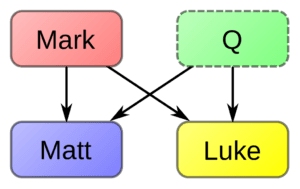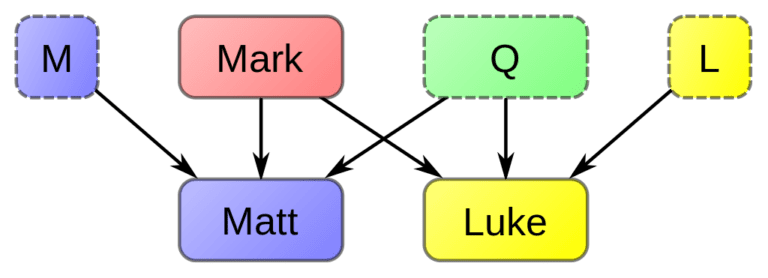Chapter 5.
New Testament
In this chapter, I discuss the origins of the New Testament, which is an assemblage of Christian texts written by various authors at different times after the death of Jesus of Nazareth. The New Testament discusses some of the words and deeds of Jesus, his death, reports of his post-resurrection appearances, and other events that occurred in the first century of the Christian era, referred to as the Common Era (CE), which began with the estimated birth year of Jesus. The New Testament forms the second part of the Christian Bible and is considerably younger than the first part, the Old Testament. The Old Testament is derived from the Hebrew Bible, but divided into thirty-nine books, instead of twenty-four. Christians regard both the Old and New Testaments as sacred scripture.
The New Testament contains twenty-seven books of authoritative scripture. These were originally written in the Koine Greek language. These books include: the four canonical gospels (Matthew, Mark, Luke, and John), the Acts of the Apostles, the fourteen Epistles of Paul, the seven General Epistles, and the Book of Revelation. I will limit my discussion to the four canonical gospels.
For information about Apostle Paul, see the Kingpins of Christianity chapter.
This chapter contains the following sections:
Note: The dates in this chapter are from the Common Era (CE), which began with the birth of Jesus. The biblical scripture is from the New Revised Standard Version (NRSV).
Early Setting
An exceptional Jewish Rabi, Jesus had a loyal following. He operated in rural communities outside of the religious establishment, and many of his teachings and deeds were revolutionary. There is no record that he ever wrote anything for his followers, and nobody was recording his teachings. According to Bart D. Ehrman, Ph.D., a prolific New York Times bestselling author from Princeton Theological Seminary, most early Christians were illiterate, being from the lower, uneducated classes. Therefore, the primary form of communication was an oral tradition of stories and sayings that were shared and passed on.

Jesus came to prominence only in the last years of his life. Most people did not consider him to be divine until after his physical death, when he began appearing to his followers. Jesus’ after-death appearances led his followers to expect him to return. But in time, when he still hadn’t returned, some of his literate followers felt a need to memorialize his life and teachings. They gathered sayings, parables, miracle stories, and so on, from oral tradition, and wrote the earliest gospels. These gospels were all written anonymously. Those early gospels, along with other written collections and then-current oral tradition, served as the foundation for the four canonical gospels. These are the only gospels approved—canonized—as true gospels of Jesus by the early Christian church.
Note: It was not until the 5th century that the different Christian churches finally reached an agreement on biblical scripture. Before then, alternative Christian texts, such as the Nag Hammadi Gnostic gospels, flourished.
The Four Canonical Gospels: Matthew, Mark, Luke and John
Biblical scholars estimate that the four canonical gospels were likely written between 70 CE and 110 CE—approximately forty to eighty years after Jesus died. They were not written as biography or history in the conventional sense. The authors give varying accounts of the life and teachings of Jesus. Jesus and his followers spoke Aramaic. Given that the gospels were written in Greek, some of subtle Aramaic meanings may have been obscured. Scholars hold varying opinions regarding the validity of biographical, historical, theological, and/or mythological elements that are contained in the gospels.Many Christians hold the belief that the four gospels were written by the two apostles, John and Matthew, and their companions Mark and Luke. However, the authors of these four books never claimed to be the persons whose names have been attributed to them, and none of the authors spoke in the first person. Therefore, the vast majority of biblical scholars believe that all four of these authors are anonymous and that none of these gospels were written by eyewitnesses.
Gospel manuscripts with titles (Matthew, Mark, Luke and John) first appeared about 200 CE. The life of Jesus is covered in all four books. Though there are many similarities in their portrayals, there are also outright contradictions. Each book presents the author’s own religious and political agenda. For instance, the books of Matthew and Luke have different accounts of Jesus’ birth, and the resurrection story is contradictory among all four books. There is no hard evidence that the gospels were known by these names early on. Historians believe that the books were given the names of Jesus’ disciples to imply direct links to Jesus, thereby enhancing their authority.
The copying of these manuscripts was done by scribes, well over a thousand years before the printing press was invented. The early Christian scribes were not professionals, unlike the monks in the Middle Ages. As a result, early scribes made transcription mistakes quite frequently. Recognition of such mistakes was evident in early Christianity. Origen, widely regarded as one of the most important Christian theologians of all time, complained in the 3rd Century, “The differences among manuscripts have become great, either through the negligence of some copyists or through the perverse audacity of others; they either neglect to check over what they have transcribed, or in the process of checking, they make additions or deletions as they please.” (Bart Ehrman, Misquoting Jesus)
Synoptic Gospels
The Gospels of Mark, Luke, and Matthew are called the synoptic gospels because they contain many similar stories, often in the same sequence and at times with identical wording. The strong similarity among these three gospels reflects their interdependence. The unique relationships among these gospels were recognized in the 18th century by a German biblical-textual critic, Johann Jakob Griesbach. He recognized Mark as the earliest of the four gospels and as a source used by both Luke and Matthew.
Assessing the precise origins and interrelationships among these three gospels is known as the “Synoptic Problem.” This problem has been hotly debated, eventually resulting in over a dozen recognized hypotheses. Two of the simpler hypotheses are:
- Two-document hypothesis (the double tradition): The double tradition, which was proposed by Griesbach, posits that Luke and Matthew independently used two sources. The first source was the Gospel of Mark, and the second source consisted mostly of sayings. This second source became known as “Q”, which is the first letter of the German word Quelle, meaning “source”. Griesbach’s double tradition became known as the two-source hypothesis. This continues to be the most widely accepted hypothesis.

- Four-document hypothesis: Proposed in 1925 as a refinement of the two-source hypothesis, the four-document hypothesis is also popular. It acknowledges Mark and Q as sources used by Matthew and Luke as well. But it also posits that Matthew and Luke each had a separate source in addition to Mark and Q. These additional sources are known as the M source for Matthew and the L source for Luke.

Chronological Overview
Below, I present a chronological overview of the synoptic gospels that is generally accepted by biblical scholars:- Gospel of Mark
In Christian tradition, the Gospel of Mark was traditionally placed second, as being inferior in importance to Matthew. However, since the majority of biblical scholars have determined that Mark was the first to have been written, soon after 70 CE, I have placed it first chronologically. As mentioned above, the Gospels of Matthew and Luke drew much of their material from Mark.
Mark contains comparatively little of Jesus’ teachings. It is the shortest of the four gospels, starting with Jesus’ baptism by John the Baptist and, in the original version, ending with the discovery of the empty tomb. There is no birth account, and the resurrection stories were added in later gospels.
Mark is believed to have been written in Rome for a Christian community. According to James Edwards in his book The Gospel According to Mark, there is new recognition of the author as a theologian and an artist, who used a range of literary devices to tell his concept of Jesus. And his concept included some claims that appear absurd to modern sensibilities. For example, after Jesus rose from the dead, he is quoted in Mark as having said to the eleven apostles who remained after Judas Iscariot’s betrayal, “The one who believes and is baptized will be saved;… And these signs will accompany those who believe: by using my name they will cast out demons; they will speak in new tongues; they will pick up snakes in their hands, and if they drink any deadly thing, it will not hurt them; they will lay their hands on the sick, and they will recover.” (Mark 16:17-18)
- Gospel of Matthew
Most biblical scholars believe this gospel was written between 80 and 90 CE. In early Christianity, Matthew was the most influential of the Synoptic Gospels. This gospel, like the others, was written anonymously. A degree of consensus exists among scholars that Matthew was likely written by a Jewish Christian, who was writing for Christians of a similar background in a community in Antioch in Syria. Consequently, Jesus’ fulfillment of prophesies in the Hebrew Bible is emphasized. Jesus is portrayed as a new lawgiver, whose divine mission was verified by the miracles he performed.
The divine nature of Jesus was a critical issue in this community, polarizing the early Christians and their Jewish neighbors. Among the items covered in the Gospel of Matthew is the portrayal of Jesus as Israel’s Messiah—the Son of God from birth. This gospel tells of the rejection of Jesus by his own people, his departure from the Second Temple, his crucifixion and resurrection, and his anticipated return to judge the world.
- Gospel of Luke
The author of the Gospel of Luke wrote two books. The first is the third gospel, Luke, about the life and teachings of Jesus. The second is the book of Acts, which is an account of the expansion of Christianity after the life of Jesus to nearly the end of Paul’s ministry. Together, these two works referred to as Luke-Acts account for 27.5% of the New Testament. As with Matthew, sources for Luke’s material came from Mark and Q, and also, the four-document hypothesis posits other material, referred to as the L (for Luke), that are not found in Mark or Q.
According to John Shelby Spong, Luke is thought to be the work of an evangelist who lived in Caesarea sometime between 83 and 90 CE. Compared to Mark and Matthew, Luke is written to a greater extent for a gentile audience. Since Luke is telling the story for a Greco-Roman audience, he is more antagonistic toward Judaism. Luke’s writings reflect the development of the Christian movement away from Judaism in favor of the Roman social and political spectrum.
Luke tells the story of Jesus in an orderly fashion, opening with his birth as the Messiah, and ending in Jerusalem with his death, resurrection, and ascension. Jesus is presented primarily as a teacher of ethical wisdom, one who is very much interested in instilling forgiveness and compassion among his followers.
The Fourth Gospel—John
The fourth canonical gospel, John, is highly literate and symbolic, which sets it apart from the three synoptic gospels. The synoptic gospels tell what Jesus said and did, whereby, John explains who Jesus is. The majority of scholars believe that the Gospel of John came from a community devoted to Jesus that evolved into the original Johannine community. Most scholars today define this as a community that held itself distinct from the Jewish culture from which it came, while nurturing a deep devotion to Jesus.
The gospel of John is similar in content and style to three other New Testament works—the Johannine epistles or letters, which are among the seven General Epistles. The vast majority of modern Johannine scholars view John as a book that went through a chain of revisions by distinct authors over a period of years. It is the youngest of the four gospels and is generally dated in the 90s CE by scholars, with final revisions completed by 110 CE.
The Gospel of John contains some text drawn from Mark and/or Luke, with similar vocabulary and with the incidents that John copied grouped in a similar order. However, though quotations of Hebrew Scriptures are found in John, there are fewer of them than in Mark, Matthew and Luke. John’s prologue tells readers of the true identity of Jesus—the Word of God through whom the world was created and who took on human form. Seven times in this gospel, Jesus is described as saying the divine name “I AM” as if it were his own; for example, “I am the way and the truth and the life”. The authors of John wanted to show that Jesus was the Messiah and that Christian religious practice and belief must be centered on Jesus.
This gospel tells of Jesus’ rejection by the Jews, followed by his gathering his disciples. John then describes Jesus’ ministry and miracles and how these antagonized the Jewish religious establishment, which decided that Jesus should be eliminated. Sensing what is coming, Jesus prepares his disciples for life without his physical presence. The Gospel of John concludes with the betrayal, arrest, trial, crucifixion, and after-death appearances of Jesus.
In Conclusion
Each of the canonical gospels has its own audience and focus:- Mark, which contains comparatively little of Jesus’ teachings, is believed to have been written in Rome for a Christian community.
- Matthew was likely written by a Jewish Christian, who was writing for Christians of a similar background. Jesus is portrayed as Israel’s Messiah—the Son of God from birth.
- Luke is written mainly for a Greco-Roman gentile audience and is somewhat antagonistic toward Judaism, reflecting the growth of the Christian movement towards Roman social and political culture.
- John probably was written by a Christian community that held itself apart from the Jewish culture from which it arose, while nurturing a deep devotion to Jesus. This gospel, which was written primarily for a gentile audience, explains who Jesus is: the Word of God through whom the world was created and who took on human form—the way and the truth and the life.
